The network of marked bicycle routes in the City of Prague has a total length of over 520 kilometres. The individual routes are broken down into arterial, main, local and supplementary, with the goal of completely relabeling them into a system marked with A and a number. The 8100 circuit cycle route (in places labelled A50) is a specific route that leads approx. 130 km around Prague. Currently it is still possible to encounter the older type of cycle route labelling (BŘ-LE, ŘE-HL etc.). The system is supplemented by cycle tourist routes.
| Basic information on bicycle infrastructure in Prague |
| Total lenght of marked cycle routes |
Total lenght of protected marked and recommended cycle routes |
One-way roads with two-way lanes for cyclists |
| 520 km |
200 km |
32.6 km (173 sections) |
| Cycle pictocorridors |
Seoparated / protected cycle lanes |
Shared cycle lanes (+bus +taxi) |
| 34.1 km |
57.8 km / 35.8 km |
32.1 km |
| Bicycle stands (two spots each) |
Advance stop lines for cyclists |
Bicycle crossings |
| 4 083 |
1 608 |
157 (of those 73 with traffic signals-TS) |
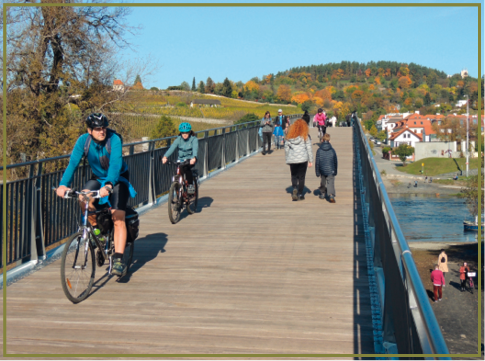
New Troja footbridge bridge
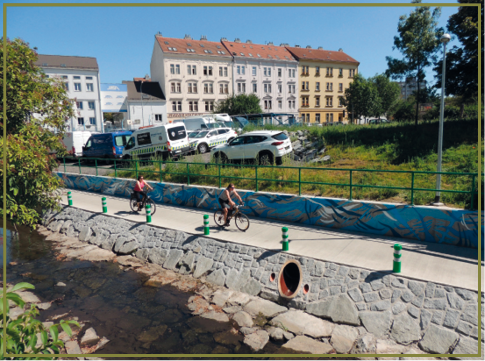
Čuprova underpass
| New bicycle infrastructure implemented in 2020 |
| Type |
Lenght / number |
Type |
Lenght / number |
| Cycle lanes (V14 / V14 protected) |
8.1 km / 18.4 km |
Shared cycle lanes (+bus +taxi) |
5.8 km |
| Cycle pictocorridors (V20) |
2.5 km |
Bicycle crossings (V8) |
40 (29 with TS) |
| One-way road with two-way lanes for cyclists |
3.3 km / 20 ulic |
Bicycle stands (two spots each) |
211 |
The new Troja footbridge was opened in October 2020, replacing the footbridge that collapsed in December 2017. The bridge was built in less than a year, and is 4 metres wide and 256 metres long. Its service life is at least 100 years. It serves pedestrians, inline skaters, cyclists and if necessary also integrated rescue system vehicles. Special sensors will monitor this footbridge connecting Troja and Císařský ostrov for its whole service life.
Among the most demanding pieces of cycling infrastructure in recent years was the underpass on the A26 cycle path completed in 2020 underneath the bridge on Čuprova. The path lies in the municipal districts of Prague 8 and 9, predominantly in the built-up area along the riverbed of the Rokytka river. It is part of the A26 cycle path “Rokytka”: Libeň – Vysočany, with the new infrastructure starting with the ramp before the Čuprova bridge, continuing under the bridge by the “water passage” and ending with the ramp on the other side of the bridge, where it connects to the existing cycle path on the street Nad Kolčavkou.
In November 2020, the first urban bike depot, Depot.Bike, was opened at Florenc in Prague, designed for distribution of packages around the city centre by electric freight bikes. With this step, Prague wants to alleviate public space, reduce the traffic burden and thus help improve the quality of life of the city's inhabitants. The project's pilot run is planned for 6 to 8 months and in one day couriers can deliver as many as 80 parcels from this depot.
New bike stands have also been installed at a number of sites around the city. Prague 3 has put in place a system for the parking of bikes or scooters in that municipal district. The system was named CYRIL and all the sites designed for parking bikes and scooters have been marked on a map, with the whole system gradually expanding (currently there are around 180 sites). Thanks to this, Prague 3 has the densest network for bicycle parking in Prague.
At the end of October 2020, riding through the Vyšehrad Tunnel was legalised (the right-bank A2 cycle route) with a simple adjustment to the sign. The “pedestrian path” sign had the additional “cyclist, lead your bicycle” sign removed and replaced with a “cyclists permitted” sign with a speed limit of 5 km/h. This is a significant change for the thousands of cyclists that pass through here daily.
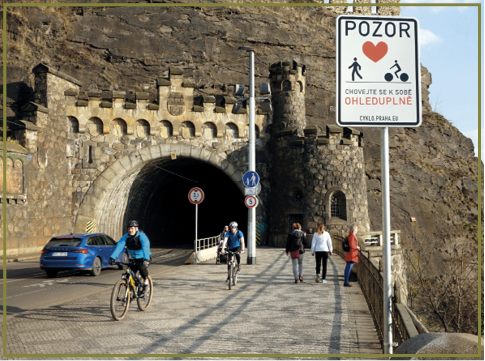
Legalisation of cyclists riding through Vyšehrad Tunnel
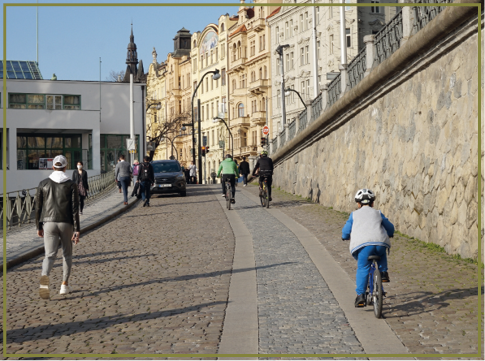
Re-paving of part of embankment by Mánes
Prague's embankments saw a re-paving of smooth strips for easier cyclist movement in 2020 (the New Town embankment between Jiráskův most and Mánes, the Old Town embankment, the embankment under Štefánikův most).
On the street Novodvorská in Prague 4, a continuous corridor addressing bicycle traffic in the main traffic area was completed after several years and stages of reconstruction.
The bicycle measures primarily implemented in Prague in 2020 were protected bicycle lanes, either on one side of the roadway (e.g. on Turistická, Husitská, Kamýcká), or on both sides of the roadway (e.g. Bucharova, Bubenská, Železničářů).
Cyclists on Prague Integrated Public Transport (PID)
In the metro it is possible to transport bicycles in the front and back part of each metro car with the exception of the first car behind the driver (max. of two bikes in each such space). Selected lifts can be used to transport bicycles at metro stations – currently Anděl, Bořislavka, Černý Most, Háje, Chodov, Ládví, Letňany, Národní třída, Nemocnice Motol, Palmovka, Pankrác, Petřiny, Prosek, Roztyly, Skalka, and Střížkov. The lifts are marked with a blue bicycle pictogram.
On trams, bicycles can only be transported on selected stretches heading out of the centre. Bikes can only be transported in the spots designated for transporting prams (for short cars generally at the back, for articulated trams at one or more spots in the middle). At most 2 bicycles can be transported in each such spot. Before entering or exiting the vehicle, passengers with a bicycle shall signal the driver, who may refuse them entry.
On buses, the transport of bicycles is not permitted (even if they are filling in for trams or metro), except for the 147 line, the AE bus (Airport Express) and the bicycle bus (Dobřichovice – Kytín). Transport was possible on the 147 line on the route Dejvická – Výhledy from 28 March to 29 October in 2020, only when heading out of the centre with the bicycle loaded at the stops Dejvická (transfer from the metro) or V Podbabě (transfer from the ferry) and unloaded only at the stops Internacionální or Výhledy.
For passengers with a valid PID ticket (or document for free transport under the PID Tariff), transport of bicycles is free on trains within Prague (zones P, 0 and B), as it is in the metro, trams, the funicular and on ferries, while outside the city limits there is a fee.
Before or after taking PID connections it is also possible to store bicycles in lockable bike boxes (by OC Chodov, at the Kbely train station, at the Main Train Station and at P+R Běchovice Centre once it is opened) or deposit them for free at certain P+R lots (Černý Most 1, Depo Hostivař, Holešovice, Ládví, Letňany, Opatov, Nové Butovice, Radotín, Rajská zahrada, Skalka 1 and Zličín 1).
Automatic bicycle counters
Bicycle counters provide useful data on cycle path traffic in real-time. Monitoring of volumes is carried out with the help of bicycle counters located on the arterial cycle path network in Prague. Currently there are two types of technology used: induction loop or radar, with some locations combining both technologies. The passage of cyclists is recorded directly at the measurement point, distinguishing the direction of travel, and each location provides information on both directions. The data also take note of the current temperature and are recorded in real-time (or rather 5-minute intervals) into the City of Prague data platform, Golemio.
In comparing 2020 and 2019, a growth in the volume of cyclists of 38 % can be seen. The results of the automatic bicycle counters were significantly impacted by the SARS-CoV-2 pandemic in 2020 (interest in outdoor sports activities increased, bicycle sales grew, people were afraid of taking public transport due to the infection risk). The Povltavská and Modřany profiles have long been the locations with the highest number of cyclists detected in both directions. The month with the highest number of detected cyclists was July.
Annual variation of bicycle traffic 2019 according to automatic bicycle counters

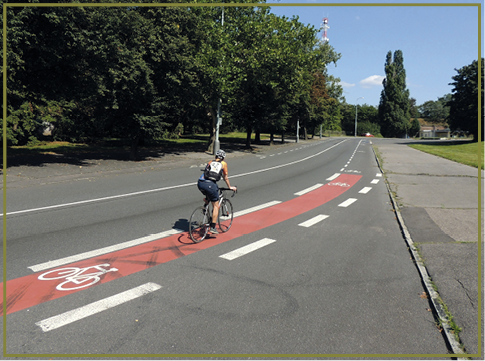
Bicycle lanes and protected bicycle lanes on Vaníčkova

The Novodvorská bicycle lane
Results of cyclists accidents in Prague 2010-2020 (source Traffic Police Department, City of Prague Police)










